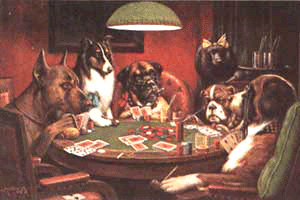Poems:
The Power of the Dog by Rudyard Kipling"Beggar at the Manor": from The Odysseyby Homer--the story of Argos the dog and his final recognition of Odysseus (disguised as a beggar).
From Edward Abbey's Down the River
Philippians 3:2 -- "Watch out for those dogs, those men who do evil, those mutilators of flesh."
Revelation 22:15 -- "Outside are the dogs, those who practice magic arts, the sexually immoral, the murderers, the idolaters, and everyone who loves and practices falsehood."
-- Holy Bible, New International Version."Dog's Death" by John Updike
What if Updike had titled the poem "Good Dog" instead of "Dog's Death"?
Your Dog Dies by Raymond Carver
Carver's poem is reflexive in that the poet depicts art as awareness of art--it is a poem about writing a poem. We may call this kind of artistic self-awareness as belonging to postmodernism. However we see this "shattering of the illusion" in the works of William Shakespeare too: read the epilogue to As You Like It, a pastoral play which embodies the idea of taking sophisticated people and placing them suddenly within the rustic life of which they have no previous knowledge. And thus they discover "truths" undisclosed in the court. As You Like It begins with a disordered society and a corrupt court. Rosalind, in a boy's disguise, escapes the limitations of being a woman. She consequently learns a great deal about herself and love--she could not have learned this within the normal conventions of society. This knowledge is a gift of the forest, so to speak, something that is learned in the world outside. In the end, most of the characters return to the urban world joyously, and thanks to what they have learned, they now transform the society into a new ordered society epitomized in the final dance."Eating Poetry" by Mark Strand
Diana and Actaeon from Ovid's Metamorphoses
Between 1868 and 1872 Cassius Marcellus Coolidge worked as a druggist and sign painter, founded a bank and a newspaper, then moved from Antwerp, New York, to Rochester, where he started painting dogs in human situations. His poker-playing dogs are the most famous, but he also painted dogs on a commuter train and in a ballpark. Coolidge's first customers were cigar companies that printed copies of the paintings for giveaways. Coolidge eventually signed a contract with Brown & Bigelow to turn out hundreds of thousands of copies of his dog paintings for advertising posters, calendars, and prints.
